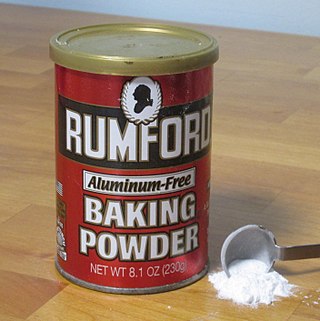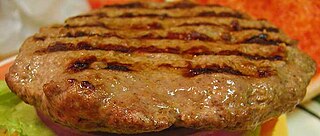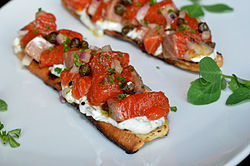
Sushi is a traditional Japanese dish made with vinegared rice, typically seasoned with sugar and salt, and combined with a variety of ingredients, such as seafood, vegetables, or meat: raw seafood is the most common, although some may be cooked. While sushi comes in numerous styles and presentation, the defining component is the vinegared rice, also known as shari (しゃり), or sumeshi (酢飯).

Sashimi is a Japanese delicacy consisting of fresh raw fish or meat sliced into thin pieces and often eaten with soy sauce.

Tartar sauce is a condiment made of mayonnaise, chopped pickles or relish, capers, and herbs such as tarragon and dill. Tartar sauce can also be enhanced with other herbs, lemon juice, and olives. It is most often served with seafood dishes such as fish and chips, fish sandwiches, fish fingers, fried oysters, and calamari.

Baking powder is a dry chemical leavening agent, a mixture of a carbonate or bicarbonate and a weak acid. The base and acid are prevented from reacting prematurely by the inclusion of a buffer such as cornstarch. Baking powder is used to increase the volume and lighten the texture of baked goods. It works by releasing carbon dioxide gas into a batter or dough through an acid–base reaction, causing bubbles in the wet mixture to expand and thus leavening the mixture.

Cheesecake is a dessert made with a soft fresh cheese, eggs, and sugar. It may have a crust or base made from crushed cookies, graham crackers, pastry, or sometimes sponge cake. Cheesecake may be baked or unbaked, and is usually served chilled.

August Oetker was a German inventor, food scientist and business person. He is known as the creator of baking powder as a ready-to-use product, and also as the founder of the Dr. Oetker company. He was the patriarch of the Oetker family.

Steak tartare or tartar steak is a French dish of raw ground (minced) beef. It is usually served with onions, capers, parsley or chive, salt, pepper, Worcestershire sauce, and other seasonings, often presented separately, to be added to taste. It is commonly served topped with a raw egg yolk. It is similar to the Levantine kibbeh nayyeh, the Turkish çiğ köfte, the German Mett and the Korean yukhoe.

Rudolf August Oetker colloquially also R.A. Oetker was a German industrialist, businessman, ship owner and philanthropist. Most notably he turned Dr. Oetker, founded by his grandfather August Oetker, into a multinational food conglomerate. During World War II, Oetker was a member of the Nazi Party.

Poke is a dish of diced raw fish tossed in sauce and served either as an appetizer or a main course.

A patty is a flattened, usually round, serving of ground meat or legumes, grains, vegetables, or meat alternatives. Common ground meat used include beef, bison, elk, turkey, chicken, ostrich, and salmon. Patties are found in multiple cuisines throughout the world.

If You Love This Planet is a 1982 Canadian documentary short film directed by Terre Nash, produced by Studio D, the women's unit of the National Film Board of Canada.

Dr. Oetker is a German multinational company that produces baking powder, cake mixes, frozen pizza, pudding, cake decoration, cornflakes, birthday candles, beer, and various other products.
Hero Group is a private, consumer food manufacturer and marketing company based in Switzerland. Focusing baby and toddler food, healthy snacks, and natural spreads, the group brands include Corny Snack Bars and Semper Baby food.
Ellio's Pizza is an American brand of frozen pizza owned and distributed since 2020 by G.A. Productions LLC of Lodi NJ. Ellio's was previously owned by Dr. Oetker, a German corporation and earlier by McCain Foods, a Canadian corporation, which sold it to Dr. Oetker in 2014.

Stippgrütze, also called Wurstebrei, is a German dish from Westphalia which is similar to Grützwurst or Knipp. It consists of barley groats cooked in sausage juices (Wurstbrühe), which are enriched with pieces of meat, offal, such as heart, kidney or liver and seasoned with spices and salt. More rarely, finely chopped onions are added. The cooked ingredients are minced after the juices have been poured off and a crumbly cake is left which is held together with fat and which sets on cooling. There are various recipes, but they all contain barley groats, fat and meat.

Salmon is a common food fish classified as an oily fish with a rich content of protein and omega-3 fatty acids. Norway is a major producer of farmed and wild salmon, accounting for more than 50% of global salmon production. Farmed and wild salmon differ only slightly in terms of food quality and safety, with farmed salmon having lower content of environmental contaminants, and wild salmon having higher content of omega-3 fatty acids.
Aquagrill was a seafood restaurant located at 210 Spring Street, in SoHo in Manhattan, in New York City. It was opened in 1996 by owners Jennifer and Jeremy Marshall and closed in June, 2020, due to the economic effects of the COVID-19 pandemic.
Richard Oetker is a German billionaire heir and businessman, who in 2010 became CEO of multinational food processing company Dr. Oetker. In 1976 he was kidnapped by Dieter Zlof, a Slovene-born mechanic, and only released after a substantial ransom was paid. As of October 2021, his net worth was estimated at US$2.7 billion.

A bagel and cream cheese is a food pairing that consists, in its basic form, of a sliced bagel spread with cream cheese. Bagels with cream cheese are traditionally and most commonly served sliced horizontally and spread with cream cheese and other toppings.
















